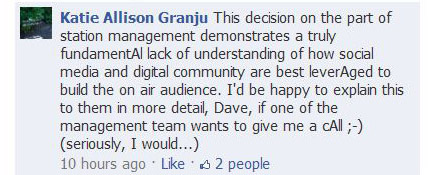Long-time Knoxville radio news broadcaster Dave Foulk has built up 4,229 friends on his Facebook page. Maybe Foulk personally knows over 4,000 people and counts them as friends; I kind of doubt it. They were there for another reason.
They had grown accustomed to his frequent, short police-scanner type posts throughout the day.
Stalled car- Chapman Highway- southbound at Stone Road
Wreck: Maynardville Highway at Brown Gap Road
Delta airliner blew a tire taking off from Atlanta for Portland blew a tire. Circled Alabama, then landed safely back at ATL
Traffic signals not working at Emory at I-75
All that ended Thursday when Foulk posted a Facebook post that said:
 That generated 57 comments (at least by early this morning); most of them were sad, many of them thanked him for the service he had provided, several were mad at the radio station he works for.
That generated 57 comments (at least by early this morning); most of them were sad, many of them thanked him for the service he had provided, several were mad at the radio station he works for.
I’m not privy to all (or any of) the factors the radio station’s management or Foulk considered, but discussions about the role of Social Media within news organizations and how it fits into newsgathering is a hot topic. How Social Meida fits into the organization’s image and how it figures into the company’s bottom line efforts are questions being discussed by news executives and publishers and general managers and station managers nearly everywhere.
If I had the answers, I’d be a Social Media consultant, or failing at that, a mere media mogul. Lacking answers, I do have some observations.
- While Foulk’s posts to Facebook weren’t generating ad revenue for the station or even page views for its website, he had built an enviable following (over 4,200 friends) that 1) realized he is a radio news guy posting news to Facebook, 2) that accepted him as a “trusted source” and 3) valued his posts as a timely service.
- From my outsider observer’s view, his posts weren’t detracting from his ability to do news on the radio.
- If you read the comments, he was providing a news service where the audience wanted to read it.
This last point cannot be overlooked as much as news organizations would like people to go our website or channel or newspaper. The audience now wants news to come to them. Or as a college student told a market researcher: “If the news is that important, it will find me.”
 Ubiquity of the media organization’s brand is a smarter strategy than a “play in my sandbox” approach. If you don’t have audience as a media company, you have nothing in any media supported by advertising. But where’s the money? Hopefully, that ubiquity will draw users to your station or channel or newspaper or website where you do have advertising environments.
Ubiquity of the media organization’s brand is a smarter strategy than a “play in my sandbox” approach. If you don’t have audience as a media company, you have nothing in any media supported by advertising. But where’s the money? Hopefully, that ubiquity will draw users to your station or channel or newspaper or website where you do have advertising environments.
Where does the individual’s brand begin and the employer’s brand begin? Unfortunately there’s no bright yellow line because the person is the human face of the faceless company. How that is managed is an evolving exploration for both the people and the companies they work for with various strategies and policies being tried, modiied, abandoned and implemented.
I think Foulk, accidentially or intuitively, had hit upon an extremely powerful way to build the credibility of himself and by extension his station as a source of real time news with his Facebok page. As a competitor, I wish his company well with their new approach. If you liked his Facebook page, you might like this one.

